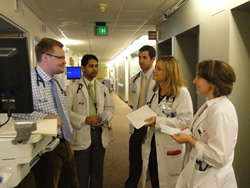Rounding Robustness
So how do you round? Any good assessment of rounding workflows requires serious self-reflection regarding your current practice. Do you document each encounter individually? Do you see three or four patients first and then document three or four progress notes in a sitting? Is there a “right” way to round on multiple patients?
Once you’ve looked at these specific considerations, it is reasonable to build technology solutions around this process. In our facility, we engaged a low-level pilot study using tablet PCs. Tablet-based rounding was deemed suboptimal for a number of reasons:
- Our current EMR architecture was not optimized for touch-based input, making data entry and documentation laborious and time-consuming.
- The Citrix-based workaround would not suspend appropriately and required a repeat login every time the tablet went to sleep.
- A dictation/transcription solution could not be utilized via the tablet modality.
We learned a great deal from the small and relatively inexpensive pilot study. From a hardware standpoint, the tablet is, I believe, still the ideal solution. Substantial pluses are battery life that is able to withstand a twelve-hour shift, the ability to turn on instantly, multitasking capabilities, and excellent screen resolution. However, for the reasons stated above, in addition to the absence of having a dedicated, streamlined way to enter data efficiently (via dictation or keyboard entry), we were prompted to look at other options. As a result, we are looking at Ultrabooks as an interim solution for our rounding hospitalists while we allow tablet-based workflows to mature to fit our needs.
As a rounding clinician, the technology solution has to work seamlessly for me before I force it upon my colleagues. If, between patient encounters, I can open my Ultrabook and have it use a biometric system to seamlessly log me in to our EMR system, allow me to quickly enter my orders, quickly and accurately dictate my progress notes, and be intelligent enough to know that closing the laptop lid suspends the system, allowing me to move on to my next patient without incident, then I will be happy. And because the EMR that I am using exists virtually on the hospital servers, I am comforted that should my laptop be stolen, no sensitive data exists on the laptop itself.
If I were able to use such a system daily in the care of my patients, day in and day out, then I might consider this system robust enough for daily hospital use.
(Image courtesy of OHSU)
